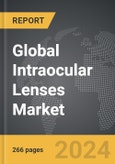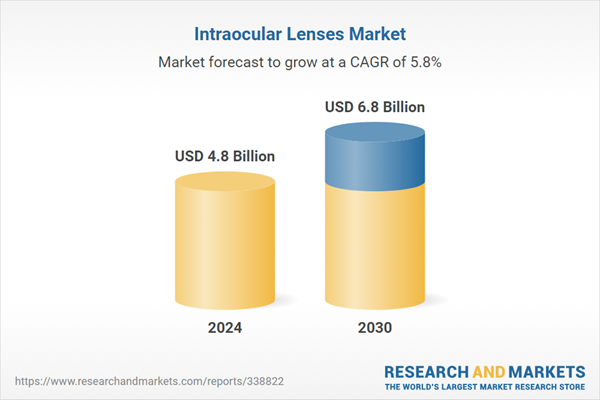The global market for Intraocular Lenses was valued at US$4.8 Billion in 2024 and is projected to reach US$6.8 Billion by 2030, growing at a CAGR of 5.8% from 2024 to 2030. This comprehensive report provides an in-depth analysis of market trends, drivers, and forecasts, helping you make informed business decisions.
The field of intraocular lenses (IOLs) is experiencing rapid advancements, particularly in presbyopia treatment, offering hope for improved patient outcomes and satisfaction. Recent innovations focus on accommodating a wide array of patient needs through technology such as multifocal, accommodating, pinhole, and extended-depth-of-focus IOLs. These advancements provide a pathway to reducing spectacle dependence and improving the quality of life for people affected by presbyopia. New IOL technology is being developed with an emphasis on personalized patient outcomes. This approach includes comprehensive clinical trials that integrate patient-reported quality-of-life measures to better understand and address individual goals. Premium IOLs, such as multifocal, toric, and accommodating lenses, have gained popularity due to their ability to address multiple vision issues simultaneously, improving patients' overall quality of life post-surgery. These lenses offer benefits like reducing the dependence on glasses and correcting astigmatism, making them a preferred choice among patients seeking comprehensive visual solutions. Moreover, advances in materials and lens coatings have significantly reduced postoperative complications and enhanced the durability and compatibility of IOLs, further boosting their market appeal. The continued technological advancements and reduced visual disturbances underscore the potential of new premium IOLs to redefine patient expectations.
Additionally, changing consumer expectations and trends toward minimally invasive and precise surgical interventions have spurred ophthalmologists and clinics to adopt innovative techniques. Femto-cataract surgery, which uses femtosecond lasers for precise incisions, is becoming increasingly popular, enabling the accurate implantation of sophisticated IOLs. The growing availability of cutting-edge diagnostic tools helps to tailor lens selection to individual patient needs, encouraging the use of advanced IOLs. As technology and accessibility continue to improve, the intraocular lens market is poised for continued growth, especially in regions with aging populations and high demand for improved vision health.
Global Intraocular Lenses Market - Key Drivers and Trends Summarized
Intraocular lenses (IOLs) have seen significant growth due to the rising prevalence of cataracts and other age-related eye conditions globally. With an aging population and increased awareness about vision health, the demand for cataract surgeries and lens replacements has surged. This demand is further bolstered by governmental and non-profit initiatives to reduce the global burden of avoidable blindness, particularly in low and middle-income regions. The growing healthcare infrastructure and improvements in surgical procedures have also made such treatments more accessible, contributing to the steady adoption of intraocular lenses.The field of intraocular lenses (IOLs) is experiencing rapid advancements, particularly in presbyopia treatment, offering hope for improved patient outcomes and satisfaction. Recent innovations focus on accommodating a wide array of patient needs through technology such as multifocal, accommodating, pinhole, and extended-depth-of-focus IOLs. These advancements provide a pathway to reducing spectacle dependence and improving the quality of life for people affected by presbyopia. New IOL technology is being developed with an emphasis on personalized patient outcomes. This approach includes comprehensive clinical trials that integrate patient-reported quality-of-life measures to better understand and address individual goals. Premium IOLs, such as multifocal, toric, and accommodating lenses, have gained popularity due to their ability to address multiple vision issues simultaneously, improving patients' overall quality of life post-surgery. These lenses offer benefits like reducing the dependence on glasses and correcting astigmatism, making them a preferred choice among patients seeking comprehensive visual solutions. Moreover, advances in materials and lens coatings have significantly reduced postoperative complications and enhanced the durability and compatibility of IOLs, further boosting their market appeal. The continued technological advancements and reduced visual disturbances underscore the potential of new premium IOLs to redefine patient expectations.
Additionally, changing consumer expectations and trends toward minimally invasive and precise surgical interventions have spurred ophthalmologists and clinics to adopt innovative techniques. Femto-cataract surgery, which uses femtosecond lasers for precise incisions, is becoming increasingly popular, enabling the accurate implantation of sophisticated IOLs. The growing availability of cutting-edge diagnostic tools helps to tailor lens selection to individual patient needs, encouraging the use of advanced IOLs. As technology and accessibility continue to improve, the intraocular lens market is poised for continued growth, especially in regions with aging populations and high demand for improved vision health.
Report Scope
The report analyzes the Intraocular Lenses market, presented in terms of market value (USD). The analysis covers the key segments and geographic regions outlined below.Segments
Segment (Standard, Premium); Product Type (Multifocal, Toric, Monofocal, Accommodative); Application (Hospitals, Ophthalmic Clinic, Eye Research Centers, Ambulatory Surgery Centers).Geographic Regions/Countries
World; United States; Canada; Japan; China; Europe (France; Germany; Italy; United Kingdom; Spain; Russia; and Rest of Europe); Asia-Pacific (Australia; India; South Korea; and Rest of Asia-Pacific); Latin America (Argentina; Brazil; Mexico; and Rest of Latin America); Middle East (Iran; Israel; Saudi Arabia; United Arab Emirates; and Rest of Middle East); and Africa.Key Insights:
- Market Growth: Understand the significant growth trajectory of the Standard Intraocular Lenses segment, which is expected to reach US$3.6 Billion by 2030 with a CAGR of a 5%. The Premium Intraocular Lenses segment is also set to grow at 6.8% CAGR over the analysis period.
- Regional Analysis: Gain insights into the U.S. market, valued at $1.3 Billion in 2024, and China, forecasted to grow at an impressive 8.8% CAGR to reach $1.5 Billion by 2030. Discover growth trends in other key regions, including Japan, Canada, Germany, and the Asia-Pacific.
Why You Should Buy This Report:
- Detailed Market Analysis: Access a thorough analysis of the Global Intraocular Lenses Market, covering all major geographic regions and market segments.
- Competitive Insights: Get an overview of the competitive landscape, including the market presence of major players across different geographies.
- Future Trends and Drivers: Understand the key trends and drivers shaping the future of the Global Intraocular Lenses Market.
- Actionable Insights: Benefit from actionable insights that can help you identify new revenue opportunities and make strategic business decisions.
Key Questions Answered:
- How is the Global Intraocular Lenses Market expected to evolve by 2030?
- What are the main drivers and restraints affecting the market?
- Which market segments will grow the most over the forecast period?
- How will market shares for different regions and segments change by 2030?
- Who are the leading players in the market, and what are their prospects?
Report Features:
- Comprehensive Market Data: Independent analysis of annual sales and market forecasts in US$ Million from 2024 to 2030.
- In-Depth Regional Analysis: Detailed insights into key markets, including the U.S., China, Japan, Canada, Europe, Asia-Pacific, Latin America, Middle East, and Africa.
- Company Profiles: Coverage of players such as Aaren Scientific Inc., Bausch + Lomb Inc., Carl Zeiss Meditec AG, EyeKon Medical Inc., Hoya Corporation and more.
- Complimentary Updates: Receive free report updates for one year to keep you informed of the latest market developments.
Some of the 28 companies featured in this Intraocular Lenses market report include:
- Aaren Scientific Inc.
- Bausch + Lomb Inc.
- Carl Zeiss Meditec AG
- EyeKon Medical Inc.
- Hoya Corporation
- Johnson & Johnson Vision Care Inc.
- Lenstec Inc.
- OPHTEC BV
- PhysIOL s.a.
- Rayner Intraocular Lenses Limited
- STAAR Surgical Company
- The HumanOptics AG
Table of Contents
I. METHODOLOGYII. EXECUTIVE SUMMARY2. FOCUS ON SELECT PLAYERSIII. MARKET ANALYSISCANADAITALYSPAINRUSSIAREST OF EUROPESOUTH KOREAREST OF ASIA-PACIFICARGENTINABRAZILMEXICOREST OF LATIN AMERICAIRANISRAELSAUDI ARABIAUNITED ARAB EMIRATESREST OF MIDDLE EASTIV. COMPETITION
1. MARKET OVERVIEW
3. MARKET TRENDS & DRIVERS
4. GLOBAL MARKET PERSPECTIVE
UNITED STATES
JAPAN
CHINA
EUROPE
FRANCE
GERMANY
UNITED KINGDOM
ASIA-PACIFIC
AUSTRALIA
INDIA
LATIN AMERICA
MIDDLE EAST
AFRICA
Companies Mentioned (Partial List)
A selection of companies mentioned in this report includes, but is not limited to:
- Aaren Scientific Inc.
- Bausch + Lomb Inc.
- Carl Zeiss Meditec AG
- EyeKon Medical Inc.
- Hoya Corporation
- Johnson & Johnson Vision Care Inc.
- Lenstec Inc.
- OPHTEC BV
- PhysIOL s.a.
- Rayner Intraocular Lenses Limited
- STAAR Surgical Company
- The HumanOptics AG
Table Information
| Report Attribute | Details |
|---|---|
| No. of Pages | 266 |
| Published | April 2025 |
| Forecast Period | 2024 - 2030 |
| Estimated Market Value ( USD | $ 4.8 Billion |
| Forecasted Market Value ( USD | $ 6.8 Billion |
| Compound Annual Growth Rate | 5.8% |
| Regions Covered | Global |









